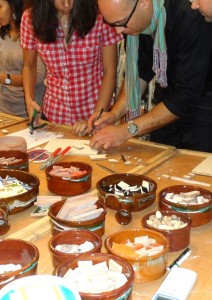
Courtesy of Darb 1718
“Life is a mosaic. Day by day, we add pieces, not always being able to see what the final result will look like. One day, we take a step back and realise the beauty of it,” said Hamid Spahi, architect, artist and mosaic instructor. It is clear from how he describes mosaic that he is in love with the process.
“My background as an artist has been formed since my childhood days in Germany; I was encouraged by my parents, who tell me that I first made a three-dimensional drawing when I was four years old.
Throughout the years at school, and later at university studying architecture and urban design, I refined my skills and techniques in free hand and perspective drawing as well as in various painting styles, printing and sculpture. As for the art of mosaic, I first applied it actively in 1999 in the UAE. In 2009 I learned skills in mosaic techniques and teaching methods in Montreal, among a vivid community of mosaic artists and businesses,” Spahi explained.
In 2010 Spahi decided to take his love of mosaic to the next level: “I decided to establish my own mosaic school and studio called Mille Pezzi (A thousand pieces) in Berlin.” In 2012 he brought his mosaic school back to Cairo.
“I founded a branch of Mille Pezzi in Cairo offering services like workshops at art centres, schools and universities as well as customised mosaic art and design for interiors and landscapes, private or commercial.”
Spahi says that mosaics combine all his interests. “As an architect I am interested in following up on materials and designs, and as an artist I study and apply various techniques. Mosaic gives me the chance to combine everything into one. While doing this I cross paths with famous architects and artists like Antoni Gaudi, who created his milestone of modernism in Barcelona, showing the true brilliance of a mosaic at the present time.”
He explained that his workshops consist of two primary stages: “First, showing the basic principles of cutting pieces with appropriate tools; second, leading students to a quick beginning of their work in order to get into a work flow and being connected with the joys of mosaic as soon as possible.” Spahi explains that improving and refining techniques is part of the entire learning process.
He says the workshops allow artists to pursue a path that interests them: “Participants get to play with a variety of colours and materials, coordinating them according to a self-made design or in an abstract way. They learn how to refine pieces through accurate cutting. Another workshop feature is learning to glue the pieces and finally to apply the grout that fills the gaps. After the beginners’ workshop participants have the knowledge to work on their own projects, like a coffee table for example.”
The workshop, Spahi claims, will also have a lasting effect on how participants view their surroundings. “After getting connected to the art of mosaic we see the world through mosaic eyes; suddenly we realise that mosaic is everywhere around us, in applications in urban environment, art in museums, interior design, et cetera,” said Spahi. He encourages participants to advance their skills by practicing their hobby and emphasises the fact that after the workshop he is always there for guidance.
“At the end of each workshop, we usually stay for a little while to exhibit and discuss the mosaic work. Each participant is free to invite family and friends, after the last session. People usually stay in contact through Mille Pezzi’s Facebook page, and there, they also get information and updates on incoming mosaic events,” he says.
Spahi is currently planning a mosaic workshop at Darb 1718, which will start on 17 March.



